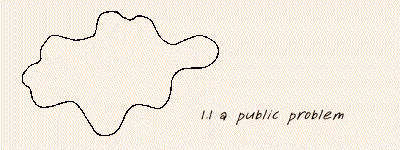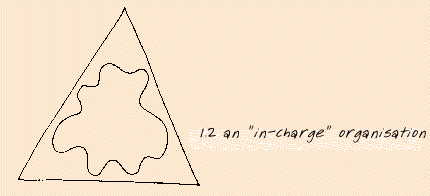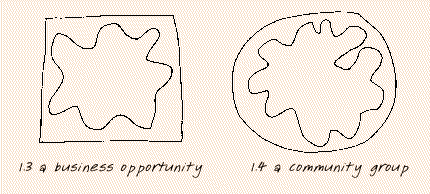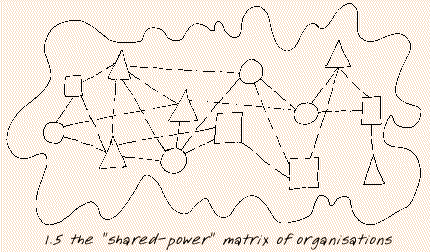|
Co-ordination, Collaboration and Co-operation ó the challenges of working together |
|
The "shared-power" world |
|
IMAGINE A MAJOR social issue or problem which can be depicted like this:
The standard "in charge" model of an organisation is one which tries to surround this problem with its solutions and programmes. You might depict it like this:
Perhaps this organisation is a government agency or local body. This institution has the statutory authority to fully encompass the problem area. The organisation at work here is often very hierarchical, like this image of a pyramid. It engages in highly-rational, expert-based planning. It is powerful and it usually makes short work of the problem ó or at least it seems to. There are, of course, a couple of varieties on this picture ...
The picture on the left represents an organisation that sees a particular public problem as a business opportunity. In the field of unemployment this might be something like a private training provider on contract to a government agency. The picture on the right represents a community group. These have a variety of organisational structures and may not be simply hierarchical. These groups are usually created to criticise the lack of official action on an issue ... and/or to have a go at doing something more effectively. The sorts of groups here might be a collective of unemployed people advocating alternatives to structural unemployment. Or they might be a collaboration between churches and service clubs, trying to run local innovative solutions to joblessness. BUT THERE IS another picture, or another way of looking at how complex social problems are being addressed. Bryson and Crosby call this the "shared-power" model. It is rooted in the world-view that accepts that a social problem like unemployment is so complex that no-one can say that they are "in charge". This view accepts that you cannot completely surround our public problems with your organisation or your solutions. In a "shared-power" world, the problems surround us. And within the problem area, there are a whole range of groups and organisations involved in getting on with their part of the solution. A "shared-power" model might look something like this:
Youíll notice there is a whole variety of organisations at work here. But they are not operating alone. They are in relationship with one another within a whole system of fluid and chaotic networks. No one is pretending they are "in-charge" here. They are taking care of their piece of the problem and getting on with their unique solutions. "The big picture" is addressed through the connections that exist between organisations. In the "in-charge" model, your effectiveness comes from your programmes and the resources you have to get the job done. In the "shared-power" world, your effectiveness is ruled by the quality of the relationships between key players, and especially their ability to work together to build trust, agreement and consensus. The challenge of leadership within this world-view is to encourage diverse people and groups to make choices together, and how to inspire the sharing of objectives, resources and authority. Now I know from working in community development groups that this "shared-power" world can be a very difficult world to work within. For a start, we canít even say that it is likely that all these different players will agree with one other. Just gaining a rough concensus or agreement on how the problem is defined ... is often a major part of the battle in itself. But, whether we like this situation or not, when I have shared this picture of a "shared-power" world to my colleagues, they have been quick to affirm that this is a realistic portrayal of the landscape they do their daily work within. |



